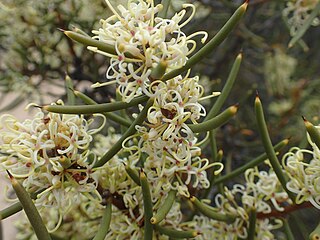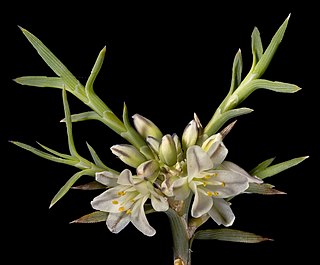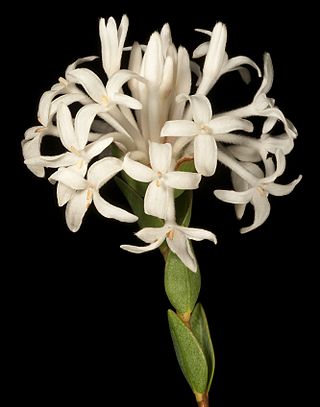Banksia acuminata is a rare prostrate shrub endemic to south-west Western Australia. It was published in 1848 as Dryandra preissii, but transferred into Banksia as B. acuminata in 2007.

Grevillea preissii is a species of flowering plant in the family Proteaceae and is endemic to the southwest of Western Australia. It is a mounded to spreading or dense, erect shrub, the leaves divided with 5 to 7 linear to more or less cylindrical lobes, and groups of reddish flowers arranged along one side of the flowering rachis.

Callitris preissii is a species of conifer in the family Cupressaceae, endemic to Rottnest Island, Australia. Common names include Rottnest Island pine, Murray pine, maroong, southern cypress pine, or slender cypress pine. The Noongar peoples know the tree as marro.

Acanthocarpus is a genus in the family Asparagaceae, subfamily Lomandroideae, in the APG III system of classification. It has been difficult to place at family rank, being placed at various times in Dasypogonaceae as well as the Asparagaceae. The entire genus is endemic to the State of Western Australia.

Actinobole condensatum is a dwarf annual herb, endemic to Western Australia.

Dichopogon is a genus of perennial herbs, native to Australia and New Guinea. It is included in the genus Arthropodium by some authorities, although recognized as a distinct genus by others. In the APG III classification system, it is placed in the family Asparagaceae, subfamily Lomandroideae.
Anigozanthos preissii, the Albany cat's paw, is a herbaceous plant species in the family Haemodoraceae, endemic to Western Australia.
Mesomelaena is a genus of sedges. It has 5 known species, all endemic to Western Australia.

Xanthorrhoea preissii, known as balga, is a widespread species of perennial monocot in Southwest Australia.

Trapezites sciron, the Sciron skipper, is a butterfly of the family Hesperiidae. It is found in the Australian states of Western Australia, South Australia and Victoria.

Calothamnus preissii is a plant in the myrtle family, Myrtaceae and is endemic to the south-west of Western Australia. It is a low-lying, sometimes ground-hugging shrub with needle-like leaves and reddish-purple flowers in spring.

Hakea preissii, commonly known as the needle tree, needle bush and Christmas hakea, is a shrub or tree of the genus Hakea native to Western Australia. The Noongar name for the plant is Tanjinn.
Wahlenbergia preissii is a small herbaceous plant in the family Campanulaceae native to Western Australia.
Carex preissii is a flowering plant in the sedge family, Cyperaceae, that is native to Western Australia.

Acanthocarpus canaliculatus is a rhizomatous perennial that fringes creeks, swamps and salt lakes and on stony sites in Western Australia. White flowers appear between June and October in the species' native range.

Chenopodium preissii is a plant in the Amaranthaceae family, native to Western Australia and South Australia.

Gompholobium preissii is a species of flowering plant in the family Fabaceae and is endemic to the south-west of Western Australia. It is an erect shrub with pinnate leaves with five to fifteen leaflets, and yellow, red and orange, pea-like flowers.

Brachyloma preissii is a plant in the heath family, Ericaceae, endemic to Western Australia. It was first described by Otto Wilhelm Sonder in 1845. The specific epithet, preissii, honours the botanist Ludwig Preiss.

Daviesia preissii is a species of flowering plant in the family Fabaceae and is endemic to the south-west of Western Australia. It is a glabrous shrub with scattered, vertically flattened, tapering, narrowly egg-shaped to elliptic, sharply-pointed phyllodes and yellow and red flowers.

Pimelea preissii is a species of flowering plant in the family Thymelaeaceae and is endemic to the southwest of Western Australia. It is an erect, spreading shrub with narrowly elliptic leaves arranged in opposite pairs, and compact clusters of many white or pink flowers surrounded by 4 green, egg-shaped involucral bracts.















